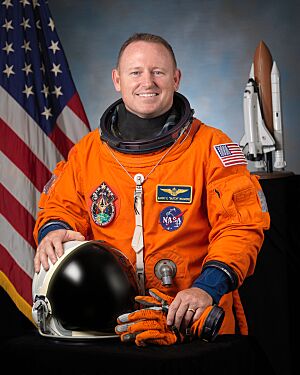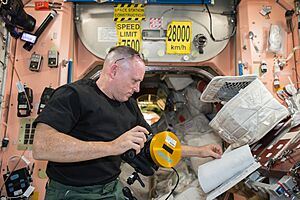Barry Wilmore facts for kids
Quick facts for kids
Barry Wilmore
|
|
|---|---|

Wilmore in 2009
|
|
| Born |
Barry Eugene Wilmore
December 29, 1962 Murfreesboro, Tennessee, U.S.
|
| Other names | Butch |
| Space career | |
| NASA astronaut | |
| Rank | Captain, USN |
|
Time in space
|
464 days, 8 hours, 2 minutes |
| Selection | NASA Group 18 (2000) |
|
Total EVAs
|
5 |
|
Total EVA time
|
31 hours, 2 minutes |
| Missions |
|
|
Mission insignia
|
|
Barry Eugene "Butch" Wilmore, born on December 29, 1962, is an American astronaut for NASA. He is also a skilled Navy test pilot.
He has flown to space three times. His first trip was an 11-day mission in November 2009 on the Space Shuttle Atlantis to the International Space Station (ISS). He was the pilot for this mission, called STS-129, with five other astronauts.
Wilmore also spent a long time on the ISS as part of Expedition 41 and Expedition 42. On June 5, 2024, he returned to the ISS on the Boeing Crew Flight Test. This was the first time the Boeing Starliner spacecraft carried a crew. He returned to Earth on March 18, 2025, aboard a SpaceX Dragon capsule with the Crew-9 team.
Before becoming a NASA astronaut in July 2000, Wilmore was an experienced Navy test pilot. He helped develop the T-45 Goshawk jet trainer aircraft.
Contents
About Barry Wilmore
Wilmore was born in Murfreesboro, Tennessee. He grew up in Mount Juliet with his mother, Faye, and father, Eugene. He has one brother who lives in Franklin, Tennessee.
Barry Wilmore is married to Deanna Wilmore. They have two daughters. The family currently lives in Houston, Texas. Wilmore is a Christian. He has spoken about how important his faith is to him. While in space, he attended online church services. He serves as an elder at Providence Baptist Church in Pasadena, Texas.
Education and Early Life
Wilmore finished high school at Mount Juliet High School in Mount Juliet, Tennessee. He earned a Bachelor of Science and a Master of Science degree in electrical engineering from Tennessee Tech. He also has a Master of Science in Aviation Systems from the University of Tennessee.
While at Tennessee Tech, Wilmore was a member of the university's football team. He was a letterman and a team captain.
Military Career
Wilmore is a very experienced pilot. He has flown for over 8,000 hours. He has also completed 663 landings on aircraft carriers. All of his flights were in fast jet aircraft. He is a graduate of the United States Naval Test Pilot School.
During his time as a Navy pilot, Wilmore went on four major deployments. He flew A-7E and F/A-18 aircraft. He flew from the decks of large aircraft carriers like the USS Forrestal and USS John F. Kennedy.
He flew missions to support military operations over Iraq and Bosnia. Wilmore completed 21 combat missions during Operation Desert Storm. His last operational deployment was with the "Blue Blasters" of Strike Fighter Squadron 34 (VFA-34).
As a Navy test pilot, Wilmore helped develop the T-45 Goshawk jet trainer. This included testing its ability to land on aircraft carriers. He also taught at the U.S. Naval Test Pilot School. Before joining NASA, he was an instructor at the U.S. Air Force Test Pilot School in Edwards Air Force Base, California.
NASA Experience
NASA chose Wilmore as a pilot in July 2000. He started his training in August 2000. After two years of training, he worked on technical issues for the Space Shuttle. This included working on the main engines and fuel tanks. He also helped support launches and landings at the Kennedy Space Center, Florida.
STS-129 Mission
In 2009, Wilmore piloted the Space Shuttle Atlantis for the STS-129 mission. This mission went to the International Space Station.
Expedition 41 and 42
Wilmore went back to space in September 2014. He was part of the Soyuz TMA-14M crew for a long stay on the International Space Station. During this mission, something amazing happened: humans made something in space for the first time!
The ISS had a 3-D printer, built by Made In Space, Inc. Wilmore needed a special wrench. Instead of waiting for a supply ship from Earth, the design for the wrench was sent to the printer. The printer then made the wrench right there in space. This wrench was later brought back to Earth for scientists to study.
Boeing Crew Flight Test

On October 7, 2020, NASA announced that Wilmore would be part of the Boeing Crew Flight Test (CFT). This was the first time the CST-100 Starliner spacecraft would carry a crew to the International Space Station. On June 16, 2022, NASA confirmed that Wilmore and Sunita Williams would fly on this test mission.
The Starliner successfully launched on June 5, 2024, with Wilmore and Williams aboard. It docked with the ISS on June 6. The mission was planned to last eight days. However, the capsule's thrusters had problems after docking. NASA decided it was too risky to bring Wilmore and Williams back on the Starliner.
The Boeing Starliner spacecraft returned to Earth without a crew on September 6, 2024. It landed safely in New Mexico. Wilmore and Williams stayed on the ISS for several months. In December 2024, it was announced they would return to Earth on a SpaceX Dragon capsule.
On January 30, 2025, Williams and Wilmore were scheduled to do a spacewalk. They were going to retrieve equipment from outside the ISS.
Finally, on March 18, 2025, Williams and Wilmore returned to Earth. They landed in a SpaceX Dragon capsule with the other crew members of Crew-9.
Awards and Honors
Barry Wilmore has received many awards and honors for his service. These include:
- The Legion of Merit
- The Defense Superior Service Medal
- The NASA Distinguished Service Medal
- Two NASA Space Flight Medals
He was also recognized as the "Distinguished Naval Graduate" from the Aviation Officer Candidate School. He was named "Pilot Of The Year" for the U.S. Atlantic Fleet in 1991. In 2003, Barry Wilmore was added to the Tennessee Technological University "Sports Hall of Fame."
See also
 In Spanish: Barry E. Wilmore para niños
In Spanish: Barry E. Wilmore para niños
- A Beautiful Planet – An IMAX documentary film that shows scenes of Earth. Wilmore and other ISS astronauts are featured in it.


